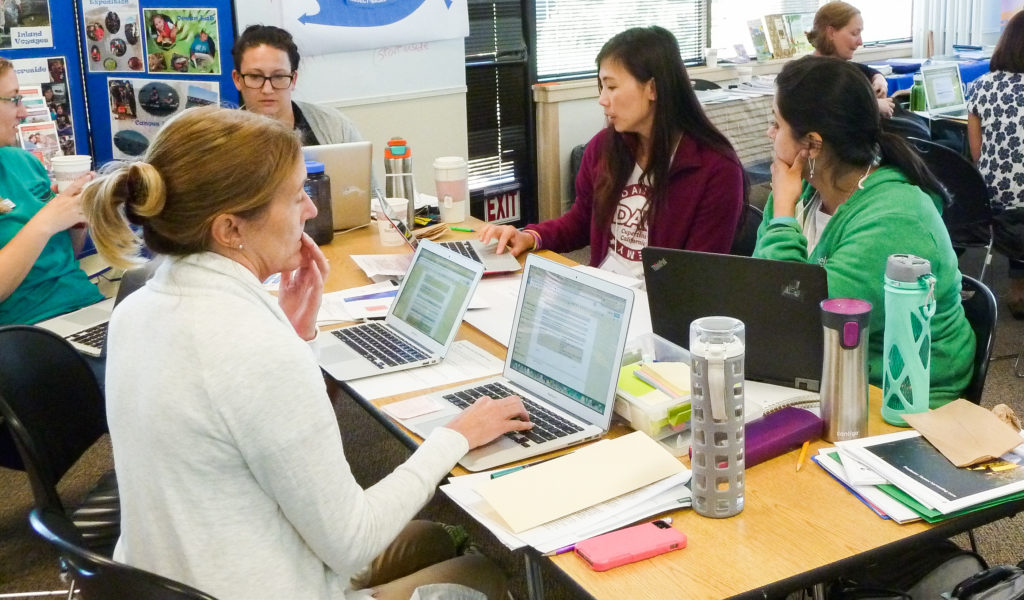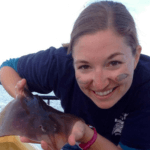At the beginning of the San Mateo Environmental Education Learning Collaborative (SM ELC) workshop, Dr. Gerald Lieberman asked us who didn’t feel comfortable or knowledgeable applying the Next Generation Science Standards (NGSS). The majority of teachers in the room raised their hands. Before we joined the SM ELC, I would have raised my hand as well. But when the Marine Science Institute was approached in early 2015 to join the collaborative, we saw it as an opportunity to get a head start and dive into NGSS.
The San Mateo Environmental Learning Collaborative is dedicated to educating teachers about NGSS, helping them design units of study, and connecting them with local nonformal environmental educators. As a nonformal provider, I was excited to have the opportunity to work closely with teachers and learn more about how educators are making the transition to implementing new standards in their classrooms. After taking the time to fully understand NGSS, it was rewarding to be able to share that knowledge with teachers and help brainstorm activities they could implement in the classroom.
The teachers that attended the institutes were absolutely phenomenal. It was inspiring to have an opportunity to work with educators that obviously love what they do, and pour their hearts into inspiring their students and giving them the best learning opportunities available. I had the pleasure of teaching and observing many of the programs that SM ELC teachers attended with us, and it was obvious that they had taken the time in their classrooms to prepare students for the experience. The students arrived ready to learn and were quickly engaged with the material. Because they were so well prepared, we were able to dive more deeply into the curriculum and spend more time exploring deeper connections.
My favorite part of participating in SM ELC was seeing the final presentations from teachers after they had taught their units. In environmental education, our time with students is often limited to a one-day field trip. Although this gives us an opportunity to share our love of science with thousands of students a year, it often provides us with a very narrow view of their education, making it hard to tell if our programs are creating long-term impacts on students. But to see the teacher teams present, and share how inspired their students were was incredible. One teacher from Corte Madera Elementary said that when we brought our rocky shore animals into her classroom for our Biomimicry program, she saw one of her new students smile for the very first time as she picked up a sea star. Another teacher from George Washington Elementary said that on their Discovery Voyage aboard our Research Vessel, the R/V Robert G. Brownlee, she saw her students gain confidence in applying science.
Being able to listen to teachers talk about their units as a whole, and how they integrated science with other subjects widened my view of the entire environmental education experience. The teachers that took the time to prepare their students before their field trips, and then reflect and expand on their experiences once they got back to the classrooms, were the ones making the largest impact and most valuable connections for their students. It reinforces how important just one day in nature can be for formative young minds.
SM ELC has given us an opportunity to devote much of our time and resources to aligning our programs with NGSS. When we joined SM ELC we created an internal NGSS team of three: our school programs Coordinator Jodi Stewart, former Education Coordinator Hayley Usedom, and me, Land Program Manager Carlie Cooney. Our team has spent weeks creating alignment documents that teachers can use to decide which programs are best aligned with their standard goals. As we worked our way through the grades, it became clear to me that NGSS supports the type of environmental education that we strive to provide. It’s all about getting students to actually DO science, and not just learn about it from a book. As an organization that prides itself on hands-on, inquiry-based science education, we couldn’t ask for more.






One Response
Carly, it was so fun to read your perspective on SM ELC. I think non-formal providers like you are an essential part of teacher education in preparation for the transition to NGSS. I am happy to be partnering with MSI again this year.